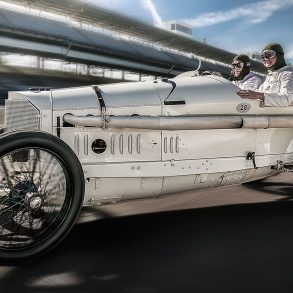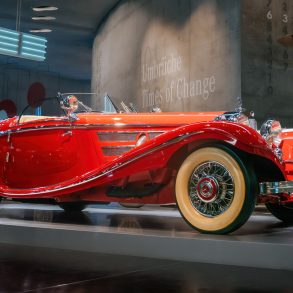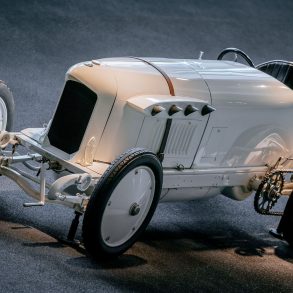In 1951, Mercedes-Benz’s successful return to the automotive industry in the post-war years was marked by two passenger cars in the form of the Mercedes-Benz 300 (W 186) and 220 (W 187).
From April 19-29, 1951, then Daimler-Benz AG launched two new models at the International Motor Show (IAA) in Frankfurt. Prior to this special occasion, the company had been manufacturing pre-war vehicles that had only minor updates like the 170 S (W 136) that was launched in 1949.

Mercedes-Benz returned to the international spotlight with the W 187 and W 186 at the IAA in 1951.

As early as 1948, the design phase of the two vehicles commenced with a considerable effort required to complete both vehicles. At the conclusion of the war ending in 1945, the company had started the groundwork to relaunch its plants and production systems.
The post-war period was far from a bright new era with new production machinery and materials like drawing paper, pencils, and steel sheets still very hard to come by. During winter, staff members wore woolen clothes and simply worked hard to keep warm in the poorly heated production halls and offices.

Production of the Mercedes-Benz W 187 at the Sindelfingen plant
A Six-Cylinder Model Marks the Return to the Luxury Segment
The Mercedes-Benz 220 (W 187) was instrumental in achieving two significant aspects for the brand: the six-cylinder model once again placed the spotlight back on the brand by demonstrating prestige and performance. It also allowed the brand to reclaim its pre-war top spot from other manufacturers.

Another important aspect to note is that they achieved success with a vehicle that still had pre-war designs like its floor assembly and body concept. Mercedes-Benz knew that they needed to develop a completely innovative design to satisfy their demanding customers when it came to spaciousness. In 1954, three years after they unveiled the 220, they released the “Ponton” 220 (W 180) model.
In 1951, a completely new engine allowed Mercedes-Benz to achieve its performance target. Internally, it was called M 180 and was developed under the management of Head of Engine Design, Wolf-Dieter Bensinger.
From a displacement of 2.2 liters, it generated 59 kW (80 hp) and provided an output of 26 kW (36 hp) per liter. The engine was able to deliver a usable engine speed of up to 6,000 rpm. At the time, those sorts of data measurements were unheard of for the brand.

Bensinger’s concept worked flawlessly, allowing the 220 to deliver a much superior performance. The elasticity of the engine allowed it to cruise easily over long distances. It also had a decent driving performance, like a 140 kph top speed and an acceleration of 0 to 100 kph in 21 seconds.
A Wide Variety of Body Types
The Mercedes-Benz 220 (W 187) high demands were aided in part due to the comprehensive range of body types that offered.


The Mercedes-Benz 220 was available not only as a saloon (producing 16,066 units until May 1954), but also a Cabriolet A (producing 1,278 units until August 1955), a Cabriolet B (manufacturing 997 units until May 1953), and a coupé (from December 1953 to July 1955 – 83 units) They also constructed 41 open-top touring cars to be used as police patrol cars on top of the 47 chassis made for special-purpose bodies.

The move garnered acclaim with a quote from the “Automobil Revue” magazine that was published at the Swiss capital Bern stating:
“This family car is inconspicuous and discreet from the outside with an individual character concealed by its similarity to the familiar 170 S. Its road-holding qualities seem to adapt to the driver’s requirements; it will give its all only to those who demand it.”
Ultimate Class: Mercedes-Benz 300 (W 186)
With the 220 being already a classy vehicle, the Mercedes-Benz 300 (W 186) raised the bar considerably higher. When it made its debut at the 1951 IAA, Mercedes-Benz offered a vehicle for effective appearances

Heads of state, entertainment tycoons, and business leaders had their own 300. Unsurprisingly, the car became the official vehicle for Germany’s Federal President and Federal Chancellor.
This was especially true for Federal Chancellor Konrad Adenauer. For fifteen years, he used a variety of Mercedes-Benz 300s during his time in office, leading to the vehicle developing the nickname “Adenauer Mercedes” – a term that is still used today.

The Chancellor was conscious of the importance of creating an impression in keeping with his standing. During his official state visit to Moscow in 1955, he took along the Mercedes-Benz 300 to be ferried appropriately around the Soviet capital.
Today, the Federal Republic of Germany’s Haus der Geschichte (House of History) in Bonn exhibits one of the prestigious saloons of Chancellor Adenauer. At the Mercedes-Benz Museum in the Collection Room 4: Gallery of Celebrities, visitors are able to experience the Federal Republic’s first Chancellor’s final official Mercedes-Benz 300.

The W 186 utilized the X-oval tube frame concept and basic measurements of the Mercedes-Benz 230 (W 153) chassis that dated back to 1939. Due to the higher vehicle weight, the tube dimensions were reinforced.
From the beginning, the expected gross weight of the vehicle showed that they would need an engine output of at least 74 kW (100 hp). Based on the available production systems, they planned to use as the foundation the 2.6-liter M 159 engine that could generate 44 kW (60 hp), but it would need an almost 67 percent performance boost.
Head of Engine Design Bensinger adopted radical measures to get the engine up to the desired level.
Initially, it was designated as M 182, but they immediately saw that the 74 kW (100 hp) from 2.8-liters of displacement was not enough due to the vehicle’s weight. So, further modifications were executed such as increasing the displacement to 3 liters and using an overhead camshaft to deliver the results that the developers needed. It ended up giving them 85 kW (115 hp). The unit was then awarded the designation as M 186.
New Body and Spacious Interior
Unlike the 230 model, the engine was moved forward to be installed over the front axle, providing the occupants a generous amount of space.
Creating a new body from scratch without the use of pre-war components and was not a decision that made lightly because they were acutely aware it would imply the need for new and expensive pressing tools.
Hermann Ahrens was tasked with developing the body. Ahrens had plenty of experience; after all, many of the brand’s pre-war passenger car bodies, including the top-of-the-range models, were based on his designs.

Mercedes-Benz 220 (W 187) interior
For three years, the exclusive Mercedes-Benz 300 was produced in its original design (4,563 saloons and 455 Cabriolet Ds).
In the spring of 1954, they released a completely upgraded 300 that was internally known as ‘b’. it included features like a more powerful engine (92 kW/125 PS) as well as reinforced brakes (1,639 saloons and 136 Cabriolet Ds) .
During the spring of 1965, the 300 was officially launched (internally designated as “c”) with production for the model lasting until June 1956 (1,367 saloons and 51 Cabriolet Ds). It featured the standard three-speed Borg-Warner automatic transmission and a single-link swing axle.
Federal German Chancellor Konrad Adenauer requested a bespoke version of the vehicle with an extended wheelbase of 100 millimeters and a divider screen. The final product resulted in a rear footwell that was 140 mm larger, and the one-off was eventually added into the range.
With a delay in the debut of the Mercedes-Benz 600 (W 100) , Mercedes-Benz relaunched the 300 for a last, comprehensive overhaul. In 1957, the last version of the Mercedes-Benz 300 was launched (internally known as the “d”), and the individual model series was given the designation W 189.

It featured a petrol injection system and a more powerful output of 118 kW (160 hp) with major body modifications like a more lightweight design.
In 1960, the special bodybuilding department based in Sindelfingen produced three special long-wheelbase versions -two Landaulet variants, while the last one was a limousine. They gifted Pope John XXIII one Landaulet with the car today, finding a place within the Mercedes-Benz Classic collection. The second Landaulet and limousine were presented to the Federal German government for official state use.
This last version of the Mercedes-Benz 300 was also a remarkable success: with 3,073 saloons and 65 Cabriolet D produced.
[Source: Daimler. Photos courtesy of Daimler]











Re: “During the spring of 1965, the 300 was officially launched (internally designated as “c”) with production for the model lasting until June 1956 (1,367 saloons and 51 Cabriolet Ds)”
Do you perhaps have the years back to front?
I really enjoyed reading about the significance of the 1951 Mercedes was to the brand. It was interesting how the German Chancellor Konrad Adenauer had such influences in the cars success. He was a Chancellor as well as a car designer. This MB came out the year I was born and we both celebrated our 70th birthday’s.